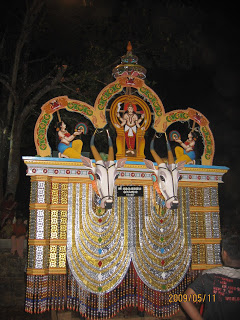Please visit the temple website below to book pujas and avail more details:
http://www.sreemulayankavubhagavathytemple.in
http://www.sreemulayankavubhagavathytemple.in
The Mulayankavu Bhagavathy Temple is dedicated to Sree Bhadrakali and is located near Kulukkallur in Palakkad district. This is a very ancient temple and here devi is consecrated in two bhava, hence called Balabhadrakali too. Mulayankavu Bhagavathi Temple, belonging to the Tharakkal family, is located at Mulayankavu village approx. 20 kms from Pattambi. This temple is famous all over South India for grand colourful "kala vela" procession during the Pooram festival.
Significance:
The speciality of the temple is that the Devi is sitting on her legs,folding her knees in the same posture as Lord Ayyappa.Usually the pratishtas will have a standing position or may be seated on peedas or their vahanas. But this status of Devi sitting in Yogapadasana revealing an asceic mood or tapobhava is unique to this temple.
The koothumadams constructed for the Ramayanam Tholpavakkothu is at the north side which shows that the Devi was facing north at some point of time.There is an interesting story behind Devi facing west as now- She was afraid of elephants.When she saw an elephant coming towards the temple during a festival,she got scared and turned her face to the west.The upset Devi turned the elephant into a stone which can still be seen towards the west of the temple.Since then,elephants are not used for festival procession in the temple.Another speciality of the temple is that there are no upadevathas in this temple. .
The koothumadams constructed for the Ramayanam Tholpavakkothu is at the north side which shows that the Devi was facing north at some point of time.There is an interesting story behind Devi facing west as now- She was afraid of elephants.When she saw an elephant coming towards the temple during a festival,she got scared and turned her face to the west.The upset Devi turned the elephant into a stone which can still be seen towards the west of the temple.Since then,elephants are not used for festival procession in the temple.Another speciality of the temple is that there are no upadevathas in this temple. .
Devotees visit this temple to seek fulfillment of the following:
- Marriage
- To get married to a person of a girl's choice
- Health and longevity of husband
History:
There are many stories associated with the temple.One such story goes like this - a mulaya woman(harijan) saw blood oozing out of a rock while sharpening her sickle. It was established as the divine presence of Devi at that place, a temple was duly constucted,and with due courtesy to the Mulaya woman the temple got the name Mulayamkavu. As a result of this,well before the temple act, all the people irrespective of their caste were allowed to enter the temple and also take part in all the functions and celebrations.
Mulayamkavil Amma is considered as Balabhadrakaali. Her posture represents the childhood and the sword and the vattaka in her hands represents the Kaali.This dual nature of Amma is visible in many matters of the temple as well.For instance,the temple has two openings,one at the north side and the other at the west.The devi is facing west unlike other temples.Only on important days and festivals,the north door would be opened.The Atrassheri Mana has the authority to open the door on important days.
Festivals:
Unlike other devi temples,every year there are two "Kala velas" and two poorams in this temple,the idapporam or the deshapporam in the meena month and the valiyappooram in medam month.The chuttuvilakku will begin on the first day of the month of vrishchika and ends with thalappoli in the month end.
The kalampaattu will begin on the first tuesday of the dhanu maasa and will be continued till the meena maasa. Nowadays paattu is gaining more significance as it creates a devotional and peaceful environment in and around the temple.Only on this occasion devi is taken outside. .
The kalampaattu will begin on the first tuesday of the dhanu maasa and will be continued till the meena maasa. Nowadays paattu is gaining more significance as it creates a devotional and peaceful environment in and around the temple.Only on this occasion devi is taken outside. .
The most colourful Kala vela in the whole state, happens at Mulayankavu temple, where "Ina kala kolangal" ( twin oxen moulds) are specially prepared for the procession. For an interesting peek into this festival,please visit the link: https://www.youtube.com/watch?v=pZXUnHxeTvs
ശ്രീ മുളയൻകാവ് ഭഗവതി ക്ഷേത്രം
പാലക്കാട് ജില്ലയില് പട്ടാമ്പി യ്ക്ക് അടുത്ത് കൊപ്പം - ചെർപ്പുളശേരി പാതയ്ക്ക് അരികെ സ്ഥിതി ചെയ്യുന്ന ഒരു പ്രധാന ദേവി ക്ഷേത്രം ആണ് മുളയൻകാവ് ഭഗവതി ക്ഷേത്രം. അനുഷ്ഠാനങ്ങൾക്കും കീഴ്വഴക്കങ്ങൾക്കും പ്രാധാന്യം ഉള്ളതാണിവിടെ. പുതുവർഷാരംഭത്തിൽ തുടങ്ങി ഒരു മാസം നീണ്ടു നിൽക്കുന്ന ആഘോഷങ്ങളോടെ പരിസമാപ്തികുറിക്കുന്നു. വള്ളുവനാട്ടിലെ അവസാന പൂരം എന്നൊരു സ്ഥാനവും ഇതിനുണ്ട്.
പ്രത്യേകതകൾ:
മേടം 1 കൊട്ടിപ്പുറപ്പാട്
2 പാനവേല
3 ചപ്പു വേല
4 കരിവേല
5 അഞ്ചാം വേല
അഞ്ചാം വേല തൊട്ട് പുലരും വരെ തോൽപ്പാവക്കൂത്തു തുടങ്ങുന്നു. പഞ്ചവടി പ്രവേശനം തൊട്ടു തുടങ്ങുന്ന രാമായണം കഥാവതരണം പൂരം കഴിഞ്ഞ് ശ്രീരാമ പട്ടാഭിഷേകത്തോടെയാണ് അവസാനിക്കുക... പൂരത്തിനു 10 ദിവസം മുമ്പെ നടക്കുന്ന ചെറുകോടുവേലയും വല്ലപ്പുഴ വേലയും വണ്ടുംതറ വേലയും പ്രസിദ്ധമാണ്..
മുളയൻകാവിൽ പൂരത്തേക്കാൾ പ്രസിദ്ധി കാളവേലക്കാണ്...
പൂരത്തിന്റ തലേ ദിവസമാണ് കാളവേല.. സന്ധ്യ മതുൽ നാനാഭാഗത്തു നിന്നും ആർപ്പും വിളികളുമായി എത്തുന്ന കമനീയമായി അലങ്കരിച്ച കാള രൂപങ്ങൾ ഓരോന്ന രോന്നായി പാതിരയ്ക്ക് അമ്പലതിരുമിറ്റത്തേക്കിറങ്ങുന്നു.നേരം പുലരും വരെ തിരുമുറ്റത്തു നിറഞ്ഞു നിൽക്കുന്ന കെട്ടുകാള കാഴ്ച മറ്റെങ്ങുമില്ലാത്തതാണ്
പകൽ പൂരത്തിന് താലപ്പൊലിയാണ് മുഖ്യം താലം നിരത്തൽ, കോമരങ്ങളുടെ നൃത്തം, അരിയേറ് തുടങ്ങിയ ഭക്തി നിർഭരമായ ആചാരങ്ങൾക്ക് പുറമെ പഞ്ചവാദ്യം മേളം തുടങ്ങിയവയും അമ്പലത്തിനു പുറത്ത് തിറ പൂതൻ കളിയും ചവിട്ടു കളിയും പൊടി പാറി നടക്കും. ഭദ്രകാളിയുടെ പ്രതീകങ്ങളാണ് തിറയും പൂതങ്ങളും.. രാവണവധം കഴിഞ്ഞ് ഭൂതങ്ങൾ കളത്തിലെത്തി ചോര കുടിച്ച് നൃത്തം വെച്ച് തിമർത്തുന്നു വെന്നാണ് സങ്കല്പം.
The temple now has a website (http://www.sreemulayankavubhagavathytemple.in) where it offers online puja booking for its devotees spread across the world. Website also has a wealth of information about the temple.







No comments:
Post a Comment